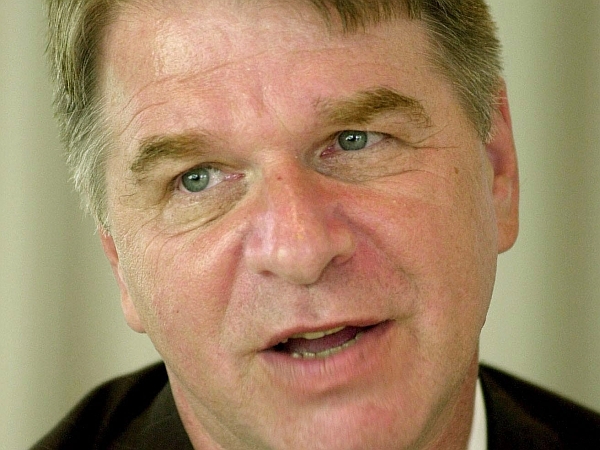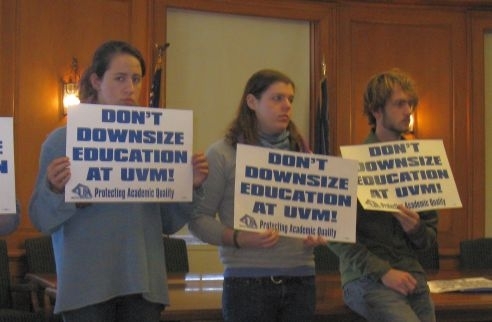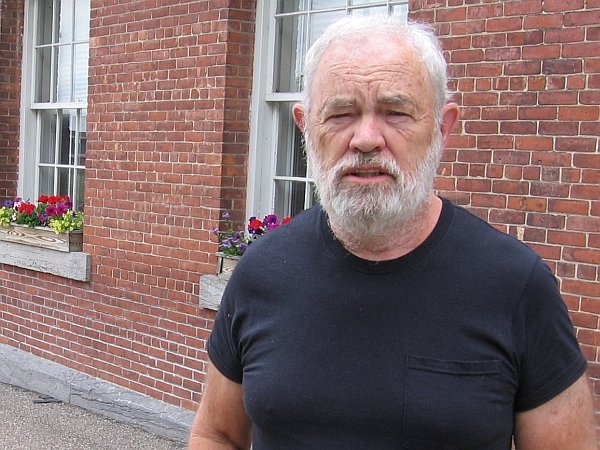UVM At A Crossroads

(Host) The University of Vermont has been in a growth phase. In the last decade, the school has invested more than $400 million on renovation and construction. And its undergraduate student body has grown from about 7,400 10 years ago to more than 10,000 today.
The expansion plan was the cornerstone of President Dan Fogel’s strategy to shore up the school’s financial base and to build revenues for the future.
Has the plan succeeded? In the second part of our series, UVM At A Crossroads, VPR’s John Dillon takes a closer look at the results of the Fogel strategy.
(Protesters) Fight for jobs and education not for Fogel’s administration!
(Dillon) On a chilly February day in 2009, students protested UVM’s plan to lay off 16 workers.
The job cuts were a response to a budget shortfall. But the students – and some of their professors – charged the crisis was more a case of misplaced priorities. They wanted President Fogel’s team to cut senior administrative salaries, not adjunct professors or maintenance workers. The crowd was surprised when they spotted Fogel walk down a nearby stairwell.
 (Protesters) "Hey that’s Fogel! That’s Fogel! Boo!
(Protesters) "Hey that’s Fogel! That’s Fogel! Boo!
(Dillon) The UVM president did not come out and talk to the demonstrators. Two years later, Fogel says he regrets that.
(Fogel) "One thing I wish, looking back, that I had done in ’08 and ’09 was to be more publicly appreciative of the passions and commitment of the people protesting. I wish I had said it at the time. I’m saying it now."
(Dillon) Katherine Nopper was one of those students whose passion for UVM led to protests.
These days, she works in downtown Burlington for a law firm. And she looks back at her time at UVM with some sadness.
(Nopper) "It’s just somehow, no matter the amount of us who were there saying we want UVM to stay this way; we want to preserve what makes UVM special, it was taken away."
(Dillon) Nopper says that with faculty cuts and a larger student enrollment, she saw some of her classes get bigger over time – a complaint that continues to be heard on campus today.
(Fox) "I didn’t have a big class until like second semester sophomore year."
(Dillon) Amanda Fox just graduated from UVM. She’s on campus this summer helping out with student orientation.
(Fox) "My professors all knew who I was, then all of I sudden I was one of a hundred students and not getting that attention."
(Dillon) Class size can be an important factor in a student’s overall academic experience. Smaller classes make it easier for students to forge a personal bond with their professors, a connection that can help launch their careers.
Evan Crockett is a senior at UVM who’s taking a summer course in physics. He says professors are still available to students, even if some classes are larger.
(Crockett) "And if you seek them out you can find them in office hours. And ultimately the reason they teach is they love students and want to pass knowledge on."
(Dillon) Statistics show that, over the last three years, there aren’t quite as many classes offered with fewer than 40 students. In that same time, the number of courses with more than 40 students has increased.
But relative to all the courses offered, the shift is small — within a percent, or less, of a change in either direction.
Still, UVM sells itself as a small but high-quality research institution, where students work closely with their teachers.
Frank Bryan, a long time political science professor, says that reputation may be at risk.
 (Bryan) "Whenever you have growth like that and economic problems you pay the price. And we paid the price on class size. I think the great challenge is to maintain the university we advertise, which is a human-scale university with interaction with professors, when you send a lot of kids into classes with 80-90-100-200 students in large lecture halls."
(Bryan) "Whenever you have growth like that and economic problems you pay the price. And we paid the price on class size. I think the great challenge is to maintain the university we advertise, which is a human-scale university with interaction with professors, when you send a lot of kids into classes with 80-90-100-200 students in large lecture halls."
(Vigoreaux) "My lab is a microcosm of what’s going on at UVM."
(Dillon) Dr. Jim Vigoreaux is Professor and Chairman of the Biology Department, where the number of students doing research has more than doubled over the past 5 years. Vigoreaux says the increase has taken a toll on the faculty who oversee all those students. But he says the extra work benefits students and professors alike.
(Vigoreaux) "So yes, it’s been an increase in workload for all of us, but, I know I speak for a lot of my colleagues in saying that this is something we strongly believe in and it’s a chore that we’re very happy to do."
(Dillon) President Dan Fogel says the school expanded enrollment without sacrificing the classroom experience. He says UVM’s student teacher ratio places it among the top 10 percent of public universities for class size.
(Fogel) "Being in the top 10 percent given the constraints that we face in a sparsely populated state with relatively low public support seems to me to be very good."
(Dillon) Among public universities, UVM’s academic rankings have fallen from their height in the late 1990s, according to the authoritative US News and World Report. UVM has not regained that stature, but the rankings did rise somewhat under Fogel, though last year UVM fell slightly to 41st among public institutions.
And there is another statistic that Fogel does not mention: the number of non-teaching administrators and vice presidents has grown under his leadership. And the growth in UVM bureaucracy became a sore point during the recent budget debates.
(Welch) "I went through and discovered in 2001 there were three top administrators whose base salaries were half a million. Today, not including the med school, there are 49 top administrators whose salaries top $8 million."
(Dillon) Nancy Welch is an English professor who has delved deep into UVM budget documents.
At the height of the budget debate two years ago, a UVM whistleblower told Welch that some of those administrators had been rewarded with five figure bonuses.
(Welch) "We’re not spending the money in the right way. Just between 2005 and 2010 the share of the operating budget going to academics fell from just above 50 percent to quite a bit below 50 percent. That’s where the crisis is."
(Dillon) Garrison Nelson has taught political science at UVM for 43 years. He admires Fogel’s scholarship, and his efforts to raise the academic bar at UVM. But Nelson says the executive bonuses sent the wrong message at a time when the budget cutbacks fell largely on lower-level staff and part time professors.
(Nelson) "These were secretive and these were lucrative. And when they were discovered, it was explained, ‘this is how you do business.’ Well, we’re not a business, we’re presumably a public university."
(Dillon) Nelson says the positive achievements of Fogel’s first seven years on the job were overshadowed by the president’s response to the budget difficulties.
(Nelson) "The problem is the more you surround yourself… with people whose jobs and salaries are dependent on your good will, the less likely you will get an honest opinion. And that’s what really undermined his legacy in the last two years."
(Dillon) Fogel disputes Nelson’s analysis. And he cites a statistical study that shows UVM does not have too many administrators for a school of its size. The president says some of the administrators were hired to deal with the complex documentation required for the school’s increasing amount of federal grants.
(Fogel) "I think there is a significant gap between perception, and what is in fact the case."
(Dillon) While the overall image of UVM has risen under Fogel’s tenure, the perception on campus is that Fogel’s leadership eroded over the last few years. English professor Philip Baruth says Fogel was viewed in very positive terms, but that many of his initiatives had their downsides.
(Baruth) "Having to do with the size and in some ways the lavishness of them. And that accumulated to the point where when we were facing these huge budget cuts three years ago, you could almost feel Fogel’s mojo slip away."
(Dillon) Now, Fogel is devoting his considerable energies to solving a budget problem that has not gone away.
In his message to trustees this spring, Fogel told the board that unless things change, the school faces a $120 million budget shortfall in five years.
For VPR News, I’m John Dillon.
In part three of our series, we’ll explore the challenges facing UVM’s next president.